The Economics and Statistics Division maintains archives of previous publications for accountability purposes, but makes no updates to keep these documents current with the latest data revisions from Statistics Canada. As a result, information in older documents may not be accurate. Please exercise caution when referring to older documents. For the latest information and historical data, please contact the individual listed to the right.
<--- Return to Archive
For additional information relating to this article, please contact:
June 29, 2020BUILDING PERMITS, MAY 2020 During the COVID-19 pandemic, comparisons of year-to-date averages and sums do not show Nova Scotia’s rapidly changing economic situation. The DailyStats will focus on year-over-year comparisons, comparing one month with the same month in the prior year. Where possible the DailyStats will make comparisons of seasonally adjusted data from the pre-COVID-19 period (January and February 2020) with the period during which COVID-19 measures were in place from March 2020 onwards.
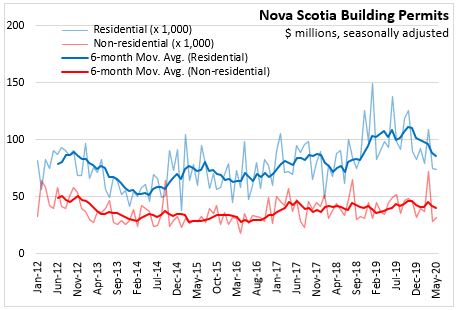
The monthly value of building permits (seasonally adjusted) issued in Nova Scotia increased 2.2 per cent in May, following a (revised) decrease of 43.1 per cent in April. Nova Scotia's residential permits decreased 1.3 per cent while non-residential building permits increased 11.4 per cent. Monthly results for building permits are highly volatile.
The six-month moving average of residential permits trended modestly upwards through 2017 and then declined in early 2018. Afterwards, residential permits resumed an upward trend before flattening out over the 2019 and have been declining in recent months. The six-month moving average for non-residential permit values remained relatively flat from mid-2017 to late 2018. Since early 2019, non-residential permits have trended upward but have peaked at the end of the year and declined in 2020.
The trend in Nova Scotia building permit values largely reflects the trends in the Halifax market. The value of Halifax building permits increased 4.8 per cent in May 2020, reflecting a 7.6 per cent increase in residential permit values and a 4.8 per cent decrease in non-residential permit values.
The six-month moving average for residential permits in Halifax has been rising since mid-2016 except for a decline in the fall of 2017 and early 2018. Since then, Halifax residential permits trended upward before flattening out over the 2019 and declined in 2020. Non-residential permits in Halifax trended down starting in June 2017, though they have trended upward since the spring of 2019.
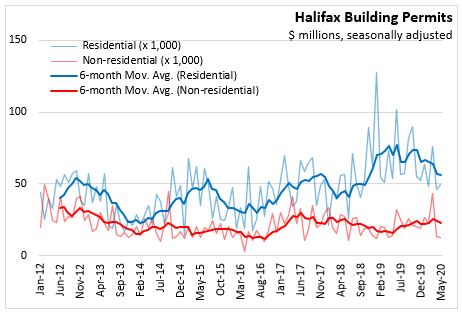
Outside the Halifax market, building permit values decreased 1.4 per cent in May 2020, reflecting a decline in residential permits (-15.6 per cent) and an increase in non-residential permits (+26.3 per cent). Non-residential permits trended upward outside of Halifax from mid-2017 to mid-2018 but have remained relatively flat in 2019 and have been declining in recent months. Residential permits were elevated for a period in 2019 and have been declining in recent months.
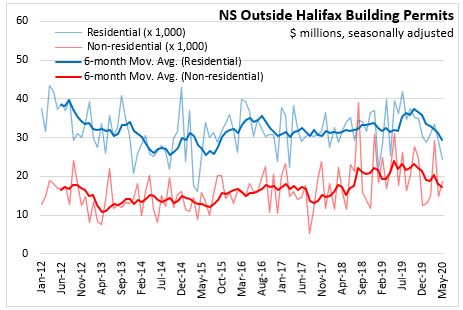
In May 2020, the value of Nova Scotia building permits was down 23.7 per cent compared to May 2019. Residential permits are down 20.5 per cent and non-residential permits are down 30.3 per cent for May 2020 vs May 2019. The decrease in non-residential building permits reflect a decline in commercial (-39.9 per cent), industrial (-6.8 per cent) and institutional (-4.0 per cent).
Halifax building permits were down 7.9 per cent in May 2020 as residential permits decreased 7.4 per cent and non-residential 9.8 per cent increased compared to May 2019. Building permits outside of Halifax were down 38.9 per cent.
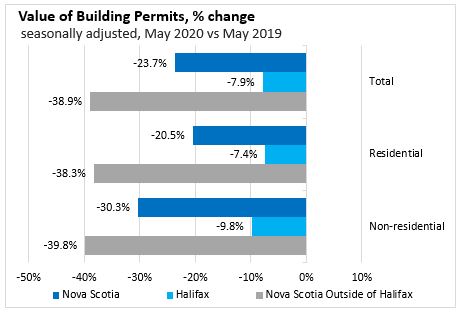
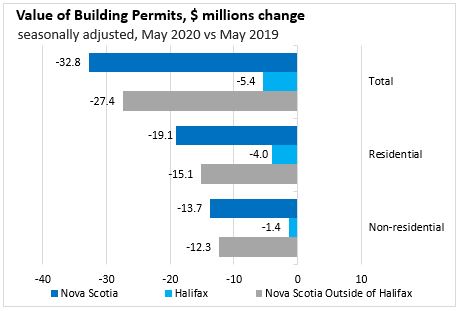
Building permits in Nova Scotia's five economic regions totaled $133.0 million (unadjusted) in May 2020. The largest contributor was the Halifax region, with a combined residential and non-residential permit value of $70.7 million. In May 2020, the total value of residential and non-residential permits was down in Halifax, North Shore, and Cape Breton region. Total permits increased in Southern NS and Annapolis Valley compared to May 2019.
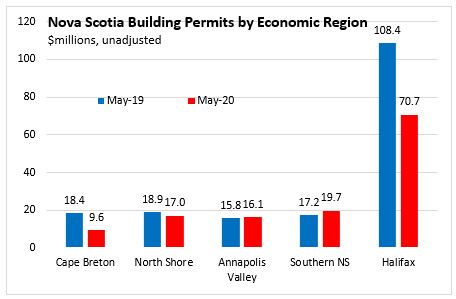
In May 2020, the number of residential dwelling-units created (seasonality adjusted) in Nova Scotia was down by 113 units compared to the May 2019. The number of single units was up for Halifax (+26) and down for Nova Scotia outside of Halifax (-28). The number of multiple units created was down both for Halifax (-95) and Nova Scotia outside of Halifax (-15).
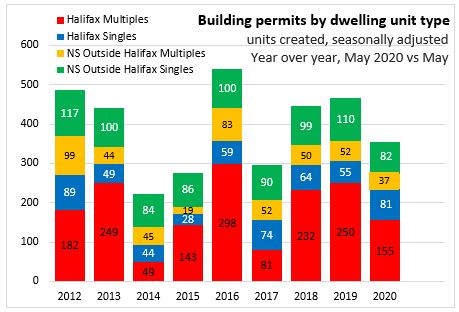
Nationally, the total value of building permits increased 20.2 per cent to $7.4 billion in May. This was the largest increase since March 2009, with the relaxation of COVID-19 construction restrictions in Ontario, Quebec, and Prince Edward Island. The May level was still 20.4 per cent below the last peak observed in January 2020.
Residential building permit values (seasonally adjusted) were on an upward trend in 2016 but have levelled off since early 2017 and declined in 2020. National residential building permits were up 18.7 per cent in May. Non-residential building permit values rose through 2017 and peaked toward the end of the year, remaining relatively flat through 2018. Since the end of 2018, non-residential permits have risen modestly and have been declining in recent months. National non-residential permit values were up 22.9 per cent in May.
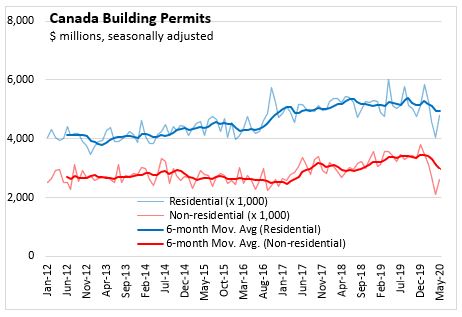
Comparing May 2020 with May 2019, national residential building permit (seasonality adjusted) values were down 6.6 per cent, with declines in all provinces except British Columbia (+19.3 per cent). New Brunswick (-43.2 per cent) showed the largest decline in residential permits in percentage terms followed by Prince Edward Island and Manitoba (-40.9 per cent) and Newfoundland and Labrador (-28.4 per cent).
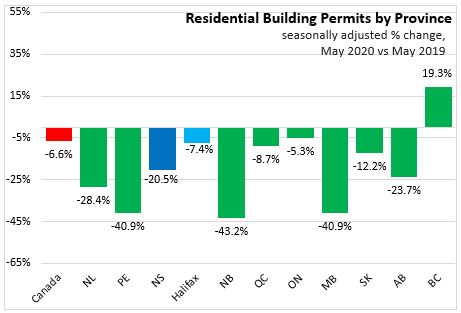
National non-residential permits (seasonality adjusted) are down 24.1 per cent in May 2020 compared with May 2019, with declines in seven provinces. New Brunswick (-75.3 per cent) had the largest decline followed by Saskatchewan (-61.8 per cent) and British Columbia (-56.0 per cent). Non-residential permits increased in Prince Edward Island (+50.1 per cent), Ontario (+8.4 per cent) and Newfoundland and Labrador (+4.3 per cent).
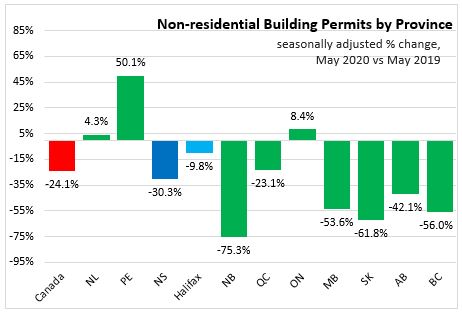
In May 2020, the national value of total (residential and non-residential) building permits was down 13.6 per cent compared to May 2019. Total building permit values were down in all provinces in May 2020, New Brunswick led with (-57.8 per cent) followed by Manitoba (-47.2 per cent) and Saskatchewan (-41.5 per cent).

Source: Statistics Canada Table 34-10-0066-01
<--- Return to Archive